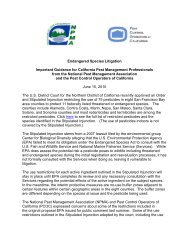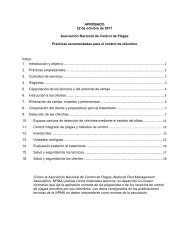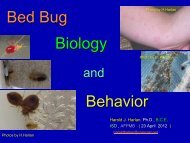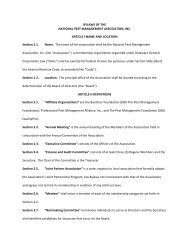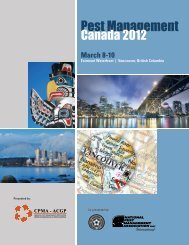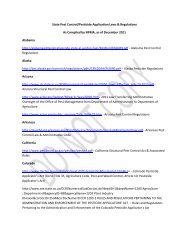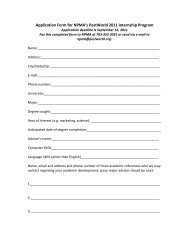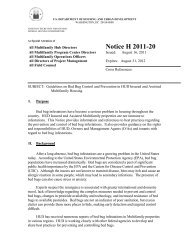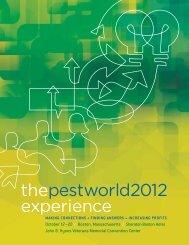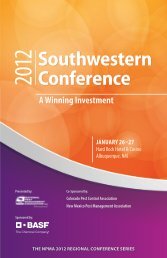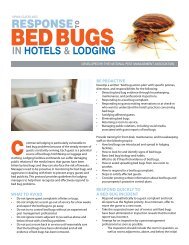Pest Management Standards For Food Plants - National Pest ...
Pest Management Standards For Food Plants - National Pest ...
Pest Management Standards For Food Plants - National Pest ...
Create successful ePaper yourself
Turn your PDF publications into a flip-book with our unique Google optimized e-Paper software.
Appendix B: <strong>Food</strong> and Drug Administration, HHS § 110.3<br />
(2) Maintaining roads, yards, and parking lots so that they do not constitute a source of<br />
contamination in areas where food is exposed.<br />
(3) Adequately draining areas that may contribute contamination to food by seepage,<br />
foot-borne filth, or providing a breeding place for pests.<br />
(4) Operating systems for waste treatment and disposal in an adequate manner so that<br />
they do not constitute a source of contamination in areas where food is exposed.<br />
If the plant grounds are bordered by grounds not under the operator’s control and not<br />
maintained in the manner described in paragraph (a) (1) through (3) of this section, care<br />
shall be exercised in the plant by inspection, extermination, or other means to exclude<br />
pests, dirt, and filth that may be a source of food contamination.<br />
B<br />
APPENDIX<br />
21 CFR Ch. 1 (4—1—01 Edition) § 110.35<br />
(b) Plant construction and design. Plant buildings and structures shall be suitable in size,<br />
construction, and design to facilitate maintenance and sanitary operations for food-manufacturing<br />
purposes. The plant and facilities shall:<br />
(1) Provide sufficient space for such placement of equipment and storage of materials<br />
as is necessary for the maintenance of sanitary operations and the production of safe<br />
food.<br />
(2) Permit the taking of proper precautions to reduce the potential for contamination<br />
of food, food-contact surfaces, or food-packaging materials with microorganisms, chemicals,<br />
filth, or other extraneous material. The potential for contamination may be reduced<br />
by adequate food safety controls and operating practices or effective design, including<br />
the separation of operations in which contamination is likely to occur, by one or more of<br />
the following means: location, time, partition, air flow, enclosed systems, or other effective<br />
means.<br />
(3) Permit the taking of proper precautions to protect food in outdoor bulk fermentation<br />
vessels by any effective means, including:<br />
(i) Using protective coverings.<br />
(ii) Controlling areas over and around the vessels to eliminate harborages for pests.<br />
(iii) Checking on a regular basis for pests and pest infestation.<br />
(iv) Skimming the fermentation vessels, as necessary.<br />
(4) Be constructed in such a manner that floors, walls, and ceilings may be adequately<br />
cleaned and kept clean and kept in good repair; that drip or condensate from fixtures,<br />
ducts and pipes does not contaminate food, food-contact surfaces, or food-packaging<br />
materials; and that aisles or working spaces are provided between equipment and walls<br />
and are adequately unobstructed and of adequate width to permit employees to perform<br />
their duties and to protect against contaminating food or food-contact surfaces with<br />
clothing or personal contact.<br />
(5) Provide adequate lighting in hand-washing areas, dressing and locker rooms, and<br />
toilet rooms and in all areas where food is examined, processed, or stored and where<br />
equipment or utensils are cleaned; and provide safety-type light bulbs, fixtures, skylights,<br />
or other glass suspended over exposed food in any step of preparation or otherwise protect<br />
against food contamination in case of glass breakage.<br />
(6) Provide adequate ventilation or control equipment to minimize odors and vapors<br />
(including steam and noxious fumes) in areas where they may contaminate food; and<br />
locate and operate fans and other air-blowing equipment in a manner that minimizes the<br />
potential for contaminating food, food-packaging materials, and food-contact surfaces.<br />
(7) Provide, where necessary, adequate screening or other protection against pests.<br />
§ 110.35 Sanitary operations.<br />
(a) General maintenance. Buildings, fixtures, and other physical facilities of the plant<br />
shall be maintained in a sanitary condition and shall be kept in repair sufficient to prevent<br />
food from becoming adulterated within the meaning of the act. Cleaning and sanitizing<br />
of utensils and equipment shall be conducted in a manner that protects against contamination<br />
of food, food-contact surfaces, or food-packaging materials.<br />
(b) Substances used in cleaning and sanitizing; storage of toxic materials. (1) Cleaning<br />
compounds and sanitizing agents used in cleaning and sanitizing procedures shall be free<br />
from undesirable microorganisms and shall be safe and adequate under the conditions of<br />
30



